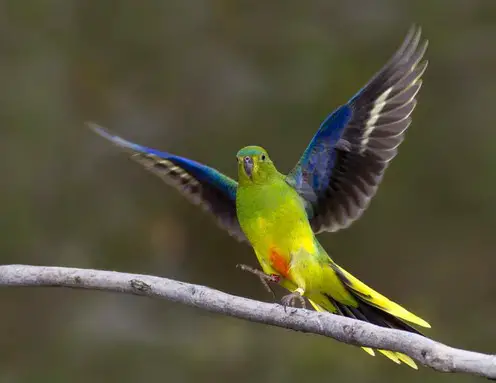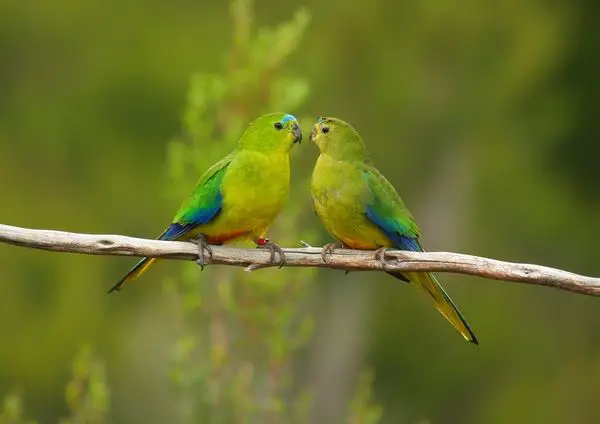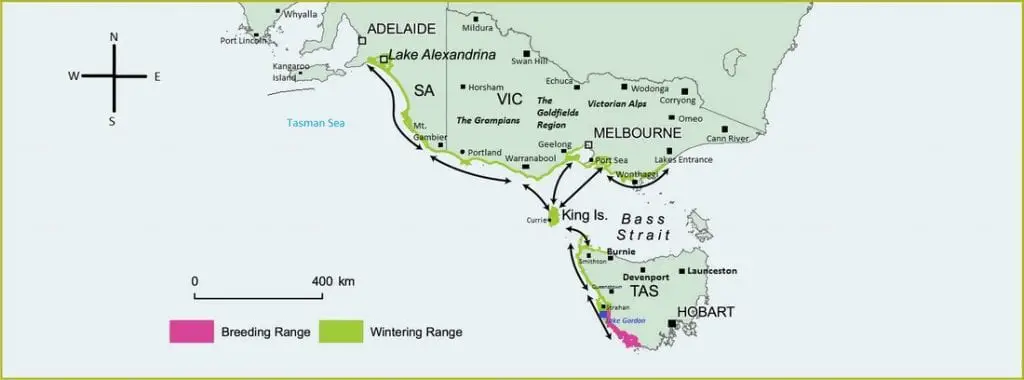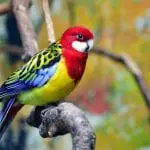Scientific Facts
| Scientific Name | Neophema chrysogaster |
| Common Name | Orange-bellied Parrot |
| Life Span | Over 2 years |
| Size | 22centimeters (8.6 inches) |
| Habitat | Bays and Saltmarshes |
| Country of Origin | Tasmania and South Australia |

Overview
The Orange-bellied Parrot is also known as Orange-bellied Grass-Parakeet, Yellow-bellied Parrot, and trumped-up corella. It is a small grass parrot, and it has an orange speck on its belly. It is a small parrot that exhibits sexual dimorphism. Orange-bellied Parrot is endemic in Southern Australia, and it is one out of three species that migrate between in the Mainland of Australia and in Tasmania.
These parrots spend summer breeding in Tasmania, while in winter, they go to the coastal Victoria and South Australia. Their breeding areas are usually in a temperate forest, while their wintering areas are mainly saltmarsh with freshwater sources or roost sites.
These parrot roost in a vacant eucalypt tree alongside a button grass plains in South West Tasmania. Its diet contains seeds and berries of small nearshore grasses or shrubs. Orange-bellied Parrots are recognized as probe among all flocks of Blue-winged Parrots.
Grievously, Orange-bellied Parrot is one of Australia’s nearly endangered species with less than 14 parrots in theory that are living in the wild as of February 2017. The International Union for Conservation of Nature (IUCN)’s mark as Red List, and it was categorized as Critically Endangered Species.
Description

The Orange-bellied Parrot is fair larger than a Budgerigar; the male or female has a bit changeable in appearance. The color of male Orange-bellied Parrot is bright grass-like green on its head, back and the majority of its wings, vanish to a yellowish-green on its breast and throat, and under its tail is a bright yellow color. There is a huge blue hoop between its eyes, surround beyond with a faint blue line, and its belly has a light orange patch. While bright blue is the color of the male parrot on the flex of its wings.
With a slighter blue, a female orange-bellied parrot is drearier, and it has a little orange belly patch. Both of the male or females have a dark-brown eye and a bill that is greyish-black and legs that is greyish-brown.
An adult male is differentiated by the light grass-like green upperparts, orange belly speck, and color yellow on its underparts. While an adult female parrot or even at its young age is duller green. Almost all birds have an acclaimed two-toned blue frontal mark and the color blue to its outer wing feathers.
It is obviously smaller than the more well-known Red-rumped parrot (Psephotus haematonotus).
Native Region or Natural Habitat

Orange-bellied Parrots are usually seen about only in some coastal or sub-coastal areas, like islands or peninsulas. They choose saltmarshes, heathlands, and low scrublands as there habitation; they also prefer grassy areas, including golf courses. The Orange-bellied Parrot spends the winter mainly within 3 km of the coast in protected coastal habitats such as bays, estuaries, coastal dunes, lagoons, and saltmarshes.
These species live in some small islands, saltworks, golf courses, and peninsulas. They breed in woodland forests on the West coast of Tasmania govern by Smithton Peppermints, but they tend to keep away from an extensive area of the wild rainforest. There is a former record from unforeseen places, as well as Shellharbour and Maroubra advise that the species may be enlarging its selection of territory and searching plant species.
These parrot breed in Tasmania then drift to the Southern Coast of Australia, with regard to West Yorke Peninsula in South Australia to the east in Victoria to Westernport Bay. Sometimes, Orange-bellied Parrot is seen elsewhere in this scale, as well as a sight in Sydney during the year 2004. The Orange-bellied Parrot is one out of two migrant parrots known in the world. Every year this parrot will move to Tasmania from the alongshore of Victoria and South Australia.
Similar Species
There are three likely-related species much the same as Orange-bellied Parrot, the Rock Parrot (N. Petrophila), Elegant Parrot (N. Elegans), and the Blue-winged Parrot (N. Chrysostoma). They are all similar in color, size, and most of them also have an orange belly, so care must be extracted when differentiating these four species. There are no subspecies that exist.
Calls
Its calls express as monosyllabic and sharp. They sometimes produce a buzzing sound, and they are often chittering sharp in alarm. The most particular alarm call that they made when they thrilled is a unique “buzzing” that described as a ‘metallic’ or ‘explosive.’ Feeding can also go along with a soft chirping, then produce a contact call in flight is a sharp ‘tzit,’ try to repeat it in a few seconds.
Care and Feeding
With the food that includes seeds, flowers, berries of shrubbery, fruits, herbaceous plants, or those plant that usually grow in salty, alkaline surroundings like saltmarshes are the food that an Orange-bellied Parrots need. They normally feed on the ground or in a low-growing shrub.
Orange-bellied Parrot habitually stays on the ground or in low vegetation looking for food, they often seen on pairs or in small flocks. They switch into feeding or resting quietly, they begin before or after sunrise, and they rest during mid-morning. During the breeding conditions, the males feed and search food constantly to provide their mate with a portion of food while they are incubating. The two parents do everything to feed their young parrot.
Before the breeding season comes, they pick places that were blazed 7-15 years earlier, while in mid-breeding time, they look out areas that are 3 to 5 years that post-fire. The Orange-bellied Parrots habitually perch during the night in tall shrubs or trees inside a 1km (0.6 mi) on their feeding locations. Its greatest major food plants are the Beaded Glasswort and Shrubby Glasswort.
Diet
For its diet, they eat seeds of button grass. They also eat seed mixes like millet, canary, buckwheat, niger, a little hemp of safflower, half-mature grass, little amount of oats, and millet sprays. They also eat green leaves like lettuce, swiss chard, dandelion, and chickweed; and a vegetable including carrot, green beans, peas, celery, and corn.
The orange-bellied parrot looks for food in low shrubs and groundcovers. Examples of flowers and berries of alkaline vegetations are chenopods or salt bushes, sea rocket, and the bidgee-widgee or acaena novae-zelandiae.
Breeding
The Orange-bellied Parrots roost in a tree-hollows, they nest in both trunks knot-holes or in dead branches, but generally not in dead trees. The empty nest cleans out by a female parrot; then, it lays its egg about two days alone. Female parrot incubates its egg and hatches its nestlings, while the male parrot is the one that takes charge in the food of a female every two to three hours. The male OBPs may provide up to 5 km apart from the nest site. When the baby parrot is about 10 days old, the female parrot leaves its babies during the day, and it helps the male parrot to feed them.
After four to five weeks after they hatch, the young birds leave their nest, and they become independent. This Orange-bellied Parrot stays with its breeding pair for the rest of its life. Young birds create a small group to search and go to the mainland about a month earlier than to those adult birds.
They usually breed during the month of November to December. They clutch a 4-6 number of eggs that have a size of 21.0 x 17.5 mm (0.8 x 0.7 inches). An adult Orange-bellied Parrot goes back to Tasmania during the month of October for them to breed, then they depart from mainland Australia from late February until mid-month of March. Young birds leave the mainland wintering grounds through the month of March to early April.
This is said that they commonly travel during at night. They are moving in the middle of their breeding grounds in South West Tasmania and in wintering areas in South East Australia. The birds perch commonly in thick Melaleuca stands.
Housing
The size of its nest-box is about 5” x 5” x “10 (12.7 cm x 12.7 x 25.4 cm). While the bird sanctuary size is about 5 x 2 x 2m (16.4 x 6.5 x 6.5 ft), and its habitat temperature is not lower than 20c or (68F).
If possible, these birds do better in a planted aviary, and they acquire any budgie-sized roosting boxes. They generally breed twice every year during spring and autumn. Each hatch contains 4 to 6 eggs, sometimes they produce about two eggs, in under absolute conditions.
Threat Summary
The mutilated and humiliation of this species is the overwintering natural environment, and by overgrazing evolution, this causes habitat loss for Orange-bellied Parrot. There is also a rivalry with some other type of birds for green food, and the male-female sex proportion is tremendously oblique as regard to males.
The wild population during 2015 they saw that 19 out of 26 baby bird infect with Psittacine Beak and Feather Disease or Psittacine Circoviral Disease (PCD). The fox and cat predation is also recognized as a warning to Orange-bellied Parrot. The mortality caused by a wreck with the structure also considered a threat to these species.
Conservation Status
Because it is known as endangered species, the orange-bellied parrot is protected under the State and Commonwealth legislation in every part of its range. They include the Orange-bellied Parrot as Red List and is considered nationally as Critically Endangered subject to the Environment Protection and Biodiversity Conservation Act of 1999 or the EPBC Act.
This species is registered as threatened under Flora and Fauna Guarantee Act of 1988 in Victoria, and an endangered species under Threatened Species Protection Act of 1995 in Tasmania, and National Parks and Wildlife Act of 1972 that establish in South Australia and listed in Threatened Species Conservation Act of 1995 in New South Wales that protect threatened species.
International Union for Conservation of Nature Resources also includes in their record the Orange-bellied Parrot as Critically Endangered ( International Union for the Conservation of Nature in 2002) as executing the Action Plan for the Australian Birds in the year 2000 and in the Advisory List of Threatened Vertebrate Fauna in Victoria (DSE 2003). The Orange-bellied Parrot is the most risk portion of the grass parrot family called Neophema.
What are the actions being taken to save the Orange-bellied Parrot?
- There are a lot of action that the government do to save the OBPs, some of them is during the year 2006, Australian Government, with the help of other state governments together with a few organizations such as the BirdLife Australia, pledged $3.2 million to preserved and inflate the lives of Orange-bellied Parrot’s habitat by the help of the following:
- They conserved by produced and covert habitat in Tasmania.
- They improved the main relocation of the natural environment, and they handle the predators in North West Tasmania and on King Island.
- They also improve managing the Orange-bellied Parrot captive breeding program.
- During winter breedings, they worked with the landowners in South Australia as well as in Victoria.
- The Victorian and Australian Governments support this project; they also provide the said funds through the Department of Environment and Primary Industries and the Corangamite Catchment Management Authority.
How Can You Help?
- Even your far in Tasmania or in the habitat of Orange-bellied Parrot, you can help to preserve them by spreading the message that this species is critically endangered.
- If you live where Orange-bellied Parrots can be seen, you can also help out by the use of keeping your cats inside your house
- Put up Orange-bellied Parrots in their nest boxes
Economic Impacts
There’s a historical data refer that the Orange-bellied Parrot was once sufficiently abundant inside its range, but it is now recorded as one of the rarest in Australian birds. Its population is now fewer than 60 birds live. It is because of straight human strikes involve the loss of some wintering grounds, and sometimes the indirect impact, which includes the rivalry for nesting sites.
The first national retrieval plan for one species was to set forward the Orange-bellied Parrot. Few progression has been made, the World Heritage Area of South West Tasmania protects the nesting zone, and any other analytical areas have been protected too. A captive breeding plan allows the birds to leave in the wild, but however; there is a process that made before the Orange-bellied Parrot will be out of danger.
Availability: Where to Get One?
You can hardly get an Orange-bellied parrot bird at pet shops in your local area. But you can go online and find bird breeders who sell other parrots online. If not, you better go to rescue organizations or shelters and adopt this type of bird.
How to Care
- Provide a wide variety of foods to sustain their diets such as millet, canary, buckwheat, and millet spray, niger, a little hemp of safflower, little amount of oats half-mature grass, and other seed mixes.
- Put their nest on a higher position. Their nest can be 22 centimeters in length and width and then 30 centimeters in height.
- After making a cage, add some accessories to make your parrots healthy and happy, such as toys, climbing ladders, and birdbath. Activity and play are important in the overall health of your parrot.
- You should show attention to your parrot’s general attitude, attitude, and behavior. Talk to the veterinarian before the situation of your parrot gets worse.
- Pay close attention to the cere of your parrot. If you notice any redness, discharge, or inflammation, your bird could be seriously ill.
FAQs
How many Orange-bellied Parrots are left?
Sadly, there are only about fewer than 50 Orange-bellied parrots left in the wild.
What is the friendliest parrot for a pet?
The friendliest parrots include canaries and finches, conures, caiques, cockatiels, lovebirds, budgies, and Meyer’s parrots.
Can parrots be potty trained?
Yes, you can potty train an orange-bellied parrot. It will just take time, consistency, patience, passion, commitment, positive reinforcement. Typically, larger birds are easily potty trained.
Why is a parrot seem so quiet?
Unusual quietness of parrots can be caused by injury, illness, lack of exercise or no activity, boredom, and more. Make sure to find time to attend to your parrot and pay attention to any changes in their behavior and appearance.
What bird is easiest to teach to talk?
Parrots are generally sociable with monk parakeets as the most sociable because they easily learn plenty of words and phrases.
What breed of parrot talks the most?
Parrots generally talk, but African Grey parrots are considered the most intelligent.
What is the easiest species of bird to teach to talk to?
The easiest types of birds to teach are Amazon parrots, cockatiels, African grey parrots, cockatoos, and budgerigars.


